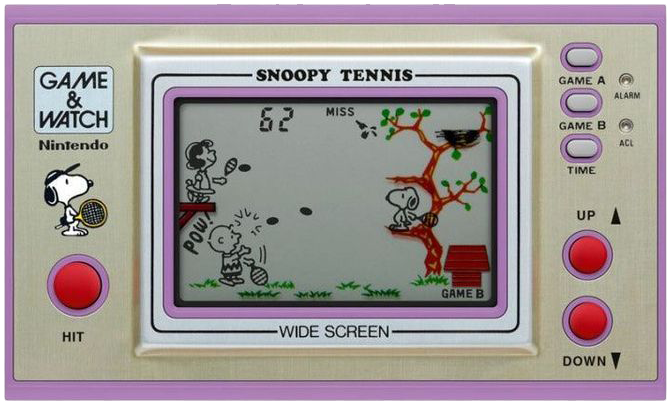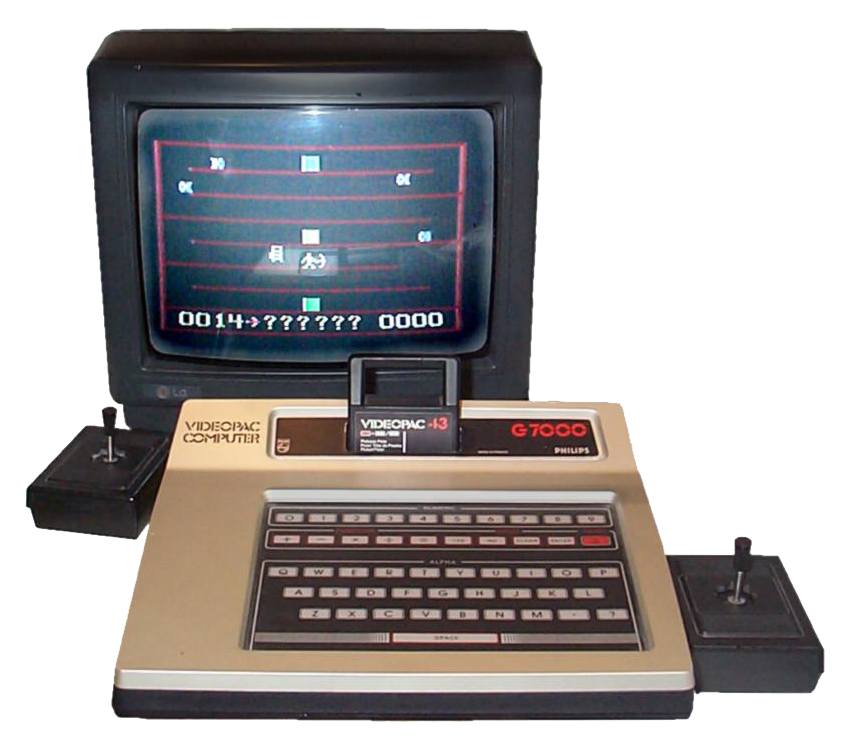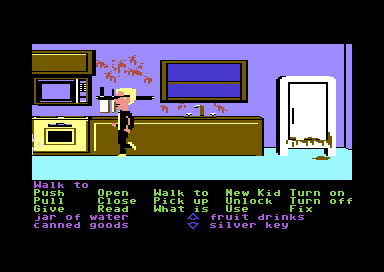

SWISSDIGITIZATION.CH
micha tarant / tarant75
Although I had the Philips Videopac G7000 cartridge system at home, I came into contact with table arcade games very often as a child. They were very common in restaurants in the late 1970s and early 1980s, much to the chagrin of my parents. In some corner, usually also near the one gambling machine that was also often found in restaurants, there was such a table with one or two stools. As a child, you registered it immediately and of course you wanted to play. A game cost Fr. 1.- and that was already very expensive at that time (it still is today). As a child, you had to struggle until you could get a franc from your parents. They always pointed out that it was too pricey, that it would be over much too quickly, and that you already had a console system at home. Nevertheless, as a child, you kept on agonizing until the franc was finally pulled out of their wallet. And indeed, the three lives that one bought for it were also used up far too quickly. The learning effect never set in that it wasn't worth it at all, and you could never master the games with just one or maybe one more franc. Every time we saw such tables, we wanted to play them.

There was already Pac Man and Space Invaders and Donkey Kong at that time. One game in particular has stayed in my memory: Wonder Boy. It was a jump-and-run game in which a Stone Age boy had to fight all kinds of enemies like snails, wasps, spiders and snakes with a stone hammer. To do this, he had to jump over various gaps. The scenery changed from forest to sea, where you had to jump on clouds. As a special feature, he could also grab a skateboard at a certain point in the game. As a kid, I couldn't make it past the first level with the three lives. But the game fascinated me so much that I kept pushing every time that you could go to this cafe. And once I succeeded, and we were there, it didn't take long for me to beg for the change I needed to finally play.
My name is Micha Rieser. My full name is Micha Louis Rieser. I was born on August 7, 1975 in Zurich. I grew up in the Aargau community of Bremgarten, where I spent my school years. After compulsory schooling in Bremgarten, I went to the High school (cantonal school) in Wohlen, but I voluntarily dropped out before taking my Matura. I left home in 1995 and have been living in Zurich ever since. I completed my apprenticeship as an electronics technician in Au ZH and in Zurich (Alcatel Schweiz AG) from 1995 to 1999. I then worked as an application developer for a small telecom company and later as a web programmer in the web factory of Condorfilms AG. I lost my job there as a result of the bursting of the dotcom bubble in 2001 and found no equivalent employment. Wanted were mainly only people, with very high programming skills. This led to my decision to study computer science. I studied communication and computer science at the Zurich University of Applied Sciences ZHAW (2002 to 2005). After that I worked for several companies as a software developer (Ergon Informatik AG 2006 to 2008, Phion AG 2008, Statistik Stadt Zürich 2009 to 2014). In addition to my job, I ran Wikipedia as a hobby very intensively since 2007 and wrote several articles and took care of community matters. This led to me becoming the first official Wikipedian in Residence in Switzerland in the second half of 2013 at the Swiss Federal Archives. I was on the new Open Data team at Statistik Stadt Zürich and worked as Wikipedian in Residence at the Swiss National Library until November 2014. I was project manager of the Swiss Open Cultural Hackathon, which took place in Bern in February 2015. I worked again as Wikipedian in Residence at the University Library of Basel from March to October and completed a Master of Advanced Studies in Library and Archive Science at the University of Zurich from August 2015 to May 2017. I worked as a scientific assistant at the Swiss Federal Archives from November 2015 to October 2018. Since November 2018, I have been an academic librarian at the Zentralbibliothek Zürich.
I came into contact with two systems when I was a child. I'm no longer sure which was the first, but they were both when I was in kindergarten (1980/1981).

Nintendo Game & Watch: A colleague in kindergarten had Fire (RC-04). I first played it on a visit when she was home with measles. I later got my own Game & Watch game as a birthday present from my godmother in 1983 and it was Snoopy Tennis (SP-30). I also got another LCD game (not Game & Watch) Frogger, which my mother bought me when I was sick and desperate to play outside with the other kids. I then promised her that I would then stay inside. My neighbor's boy had the double-screen Donkey Kong (DK-42) and my sister had Donkey Kong II (JR-55). You could buy them in toy stores, such as Franz Carl Weber. That's why they were so easy to get for the adults for birthday or as holiday gifts. I played a lot of these Game & Watch in my childhood for instance in the public bath during summer and in school camps. Many kids owned any of these Game & Watch games at that time. The most annoying thing about that time was that you couldn't turn off the beeping. Game & Watch were synonymous with kids and beeping.

Philips Videopac G7000: The second system I came in contact with as a 6 year old was the Philips Videopac G7000. This was also the first device with a microprocessor in our household. My mother bought this console system. To treat us children equally, I was only allowed to play with it when my older sister came home from school, so we both spent the same amount of time with it. My mother played more often with us kids. My father played rather less often, but it happened. And it was rather extraordinary, because he practically never played anything. Our first game was 01 "Race / Spin-Out / Cryptogram". Later we added some new ones. My favorite games were 06 "Tenpin Bowling / Basketball", 22 "Space Monster" (which is a clone of Space Invaders), 16 "Depth Charge / Marksman" (sink ships), 32 "A Labyrinth Game / Supermind", 33 "Jumping Acrobats", 37 "Monkeyshines!" *), 38 "Munchkin" (which is a clone of Pac-Man), 40 "4 in 1 Row". I got the 4 in 1 Row game as a gift from my mother because I especially wanted it. Actually, the cover appealed to me the most. But I played with it very often. Namely, there were already three difficulty levels of the built-in AI available. Playing frequently with the AI, was like training. This led to me winning first prize in the 1st elementary class in an in-class competition on 4 in 1 Row.
*) Monkeyshines! was a very unusual game. The screen had some monkeys and the players' figures and some platforms. The monkeys approached the figures and then attached themselves to the players. It was a matter of flinging them away now, whereupon they got angry for a while (you could tell by the color). And for each monkey flung away, one point was awarded. But if the player came into contact with an angry monkey, the player was killed. You had to avoid them this time until they calmed down. It was a lot of fun, especially when played with two players. We knew a trick (probably a glitch) to get as many points as possible. Someone had to collect all four monkeys on his body and then hurl them close to the wall. You got a lot of points this way, but the player never survived this action.
My mother worked a few hours a week for the church and had to maintain a membership file there. She also looked after the membership file of her gymnastics club there (SVKT Women's Sports Association) on that computer. I guess it was a Commodore of the VIC-1001 series, but it was already equipped with a floppy drive. I saw the computer once, but was not allowed to do anything with it. I still remember her story that it took her half an hour to copy a floppy disk. And for that she had to change the floppy disks umpteen times.
The two years older neighbor boy got a Commodore C64 and so his computer was my first active contact with a home computer. At first, the neighbor boy just had data cassettes that were the same format as music cassettes. Later, either at Christmas or his birthday, he was given a 5 1/4 inch floppy. I was often at his house and played some games there or watched him playing. We played World Games on his computer a few times, which had the advantage of including multiplayer. I may also remember that he had an Asterix game (Asterix and the magic cauldron), which fascinated me a lot. You had to fight Romans and hunt wild boars in the game.
I also got my first taste of the Lucasfilm adventure game Maniac Mansion there. However, I could never play it with him. But he showed it to me. I still remember the scene when the mummy appears in the bathroom behind the shower curtain and the existence of a green and a purple tentacle in the game. One of them is supposed to be friendly, but I found them both creepy and peculiar. At first, I didn't even understand what a tentacle actually was. (The concept of an adventure game fascinated me a lot, but I had to be patient until I had an Atari Mega ST 1 before I could play an adventure game myself.)

Because of my experience with his computer, it was clear that I also wanted a computer.
One of the first digital gadgets I got was a digital wristwatch. I wanted one for my first communion. In the past, it was customary to get a wristwatch for your first communion, which you then wore for the rest of your life. But as a child I didn't want to understand analog watches for a long time. I was one of the last of my age who could not read the clock. It irritated me that the small hand came to lie often between the numbers. Ex. between 6 and between 7. What is meant now? 6 or 7? I didn't want to understand how "half past six" or what "quarter to seven" or "quarter past eight" would show on the analog clock. (Not that I couldn't have grasped it in terms of intelligence, I probably didn't want to, it was too weird for me and I was just lazy). My father's video recorder, on the other hand, already had a digital display. I understood this time representation immediately and because I could calculate well for my age, it was also clear to me that 14:00 meant two o'clock in the afternoon. One had to subtract only 12 hours. And it was also clear to me that at 18:45 there were still 15 minutes missing to become seven o'clock (19:00) in the afternoon. There everything is logical. So I wanted this concept for my first wristwatch, too. And I was given an Oris digital wristwatch as a gift. It had similar functions to the widely used Casio wristwatches in the 1980s. But one difference was that it was made in Switzerland.
I enjoyed the watch for a long time. But when the Swatch came along, and I found these funny watches great, I also wanted to wear such watches. And when I wore the first Swatch, I very quickly found the analog time representation no longer difficult. I still wore the Oris from time to time, but it fell apart at some point. Probably when I was 13 or 14 years old. I then stayed mostly with analog wristwatches.
My mother bought both of us children a math learning game (Owl math Calculator) when we were in elementary school (early 1980s). She found it very useful and it was supposed to make the kids smarter instead of dumber, unlike the frowned-upon calculators. I don't remember how she knew about its existence. I think it was a recommendation from another mother. Although it was a different manufacturer, our two devices were designed the same: It was an owl with two diodes for eyes. One green and one red. And it had buttons like a calculator. And now you could enter a calculation with a result. If that calculation was right, the green diode would light up, and if it was wrong, the red diode would light up. I may remember that although we were excited about the technology, we didn't enjoy it for very long. Actually, it wasn't really anything new: like in school, you had to solve calculations and you were eventually corrected.

A short time later, my mother bought the Little Professor, which you can still buy today. Instead of diodes, it had an LCD display. She kept it for herself (so as not to cause a conflict of ownership among us kids) but we were allowed to play with it, but we lost interest very quickly. The concept was the same as with the owls. The Little Professor did not solve any calculations for us, but merely corrected them. The little face in the display smirked when we were right or looked angry when we were wrong. One of the game modes was that you were allowed to get it wrong five times until the game ended. The Little Professor came with a manual with game variations, but we weren't very interested in it. There wasn't much gameplay behind it either, but we quickly found it to be pure school material.
